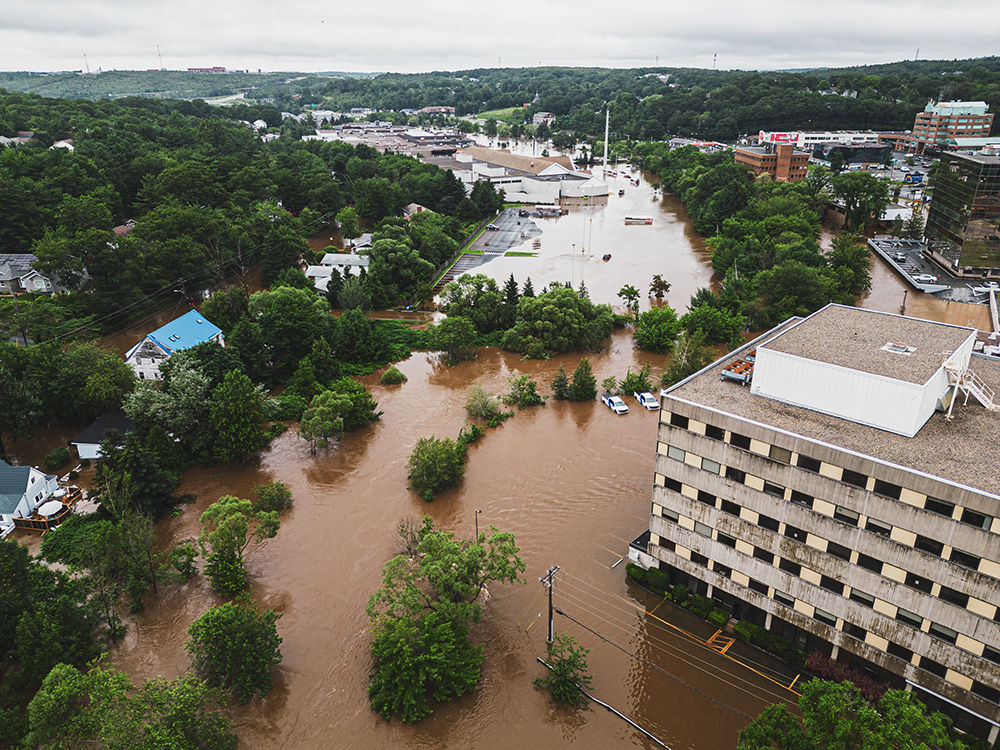Floods can occur in any region of Canada, and with over 80% of Canadians living in urban areas—and 80% of major cities situated within flood zones—most of the population lives in flood-risk areas. Flooding is the costliest natural hazard in Canada in terms of property damage.
Driven by factors such as intense rainfall, storm surges, and river overflows, floods pose a severe threat to homes, commercial properties, and public infrastructure from coast to coast. There are many different types of floods, depending on location, weather, and infrastructure, but melting snow represents the primary cause of spring flooding in this country.
Cities are especially vulnerable to urban flooding because of dense infrastructure and limited drainage systems. Heavy rain or melting snow can overwhelm storm drains and result in widespread destruction and substantial economic losses. If drainage systems are inadequate or poorly maintained, significant post-flood damage can also occur as a result of sewer backups and runoff.
Understanding the risks and taking preventative measures can reduce the impact of flooding on your property. The flood damage restoration experts at ServiceMaster Restore offer the following guide to the most common types of floods in Canada:
River Flooding
Excess rainfall, snowmelt, or ice jams can cause rivers and lakes to overflow, most often in spring when melting snow quickly raises water levels. River flooding can also result from extreme or prolonged rainfall, tropical storm systems, or melting ice and snow combined with rain, all of which can push water above riverbanks and flood surrounding areas.
Although river floods can usually be predicted ahead of time, the potential for unexpected major property damage is great if a dam or dike breaks. However, most causes of river flooding stem from storms that allow for enough warning for those in surrounding areas to evacuate safely.
Coastal Flooding
Canada’s extensive coastlines expose many communities to coastal flooding caused by heavy rainfall, extreme high winds or hurricanes, storm surges, high tides, or rising sea levels.
In many cases, several factors can combine to cause the flooding. It can also happen along ocean coasts and lake shorelines like the Great Lakes. Coastal regions with fewer defences and lower elevations are the most affected.
According to Canada’s Changing Climate report, coastal flooding is predicted to increase in the future due to the rise of the sea levels along the Atlantic, Pacific and Beaufort coasts.
Flash Flooding
Sudden, intense rainfall from thunderstorms, hurricanes, or tropical storms can trigger flash floods. The severity of flash flooding depends on rainfall intensity and duration, location, landscape, and soil conditions. Urban areas are especially vulnerable since pavement limits absorption, but dry, compacted rural soil can also fail to absorb excess water.
These floods are the most dangerous and sometimes deadly type of floods because of their sudden onset, leaving little time to prepare. Flash floods can uproot trees, destroy bridges, and severely damage homes—weakening foundations, ruining appliances, and causing long-term mould issues.
Groundwater Flooding
When groundwater levels rise, water can seep into basements and building foundations. This often occurs in areas with high water tables or during prolonged wet weather.
Groundwater floods are usually the result of drainage systems being overwhelmed by heavy rain that can cause water to overflow into streets and nearby properties. These types of floods are equally likely to occur in both urban and rural areas.
Fortunately, groundwater flooding happens gradually, giving homeowners time to remove their possessions when the water level is still shallow. Groundwater flooding can persist for weeks or months, however, and lead to increased likelihood of structural damage to properties and long-term risks such as mould.
Sewage Flooding
Sewage flooding is caused when unexpected heavy rainfall overwhelms sewage infrastructure or treatment plants, causing them to break down and release untreated sewage into the water system. Sewage floods are certainly the most unpleasant, with sewage leaking through pipes or drains or coming up through toilets, sinks, or showers.
Sewage floods pose significant health hazards, as the water becomes contaminated with harmful bacteria and chemicals that can lead to infection and disease. Fast response with thorough and detailed clean-up by technicians trained in proper sewage clean-up services is crucial.
RECOVER FROM FLOOD DAMAGE TO YOUR PROPERTY
No matter what type of flooding, the damage that can happen to your home or business can be severe. Each situation is different and requires the expertise of flood damage restoration specialists to determine the correct steps to be taken and how to best recover your property from the damage. The flood damage restoration experts at ServiceMaster Restore are ready to respond and can restore your property and peace of mind after a flood occurs.

